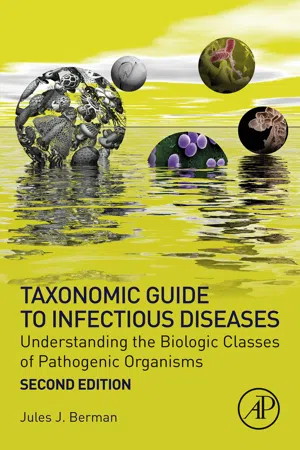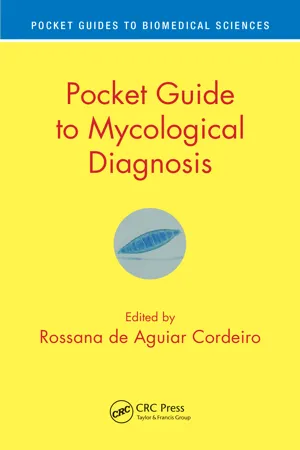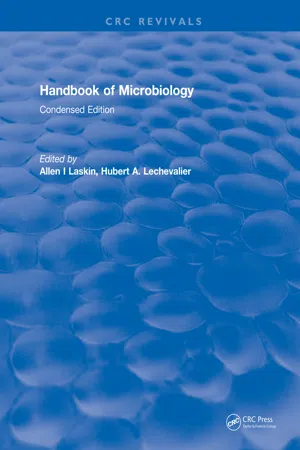Biological Sciences
Rhizopus
Rhizopus is a genus of fungi commonly known as bread mold. It is characterized by its rapid growth and ability to decompose organic matter. Rhizopus species are important in the field of biotechnology for their role in producing organic acids and enzymes, and they also have medical significance as opportunistic pathogens in humans.
Written by Perlego with AI-assistance
5 Key excerpts on "Rhizopus"
- eBook - ePub
Taxonomic Guide to Infectious Diseases
Understanding the Biologic Classes of Pathogenic Organisms
- Jules J. Berman(Author)
- 2019(Publication Date)
- Academic Press(Publisher)
Most of the pathogenic zygomycotes are noncommensal opportunists. They grow in soil, water, or air, on plants or on dung. Humans are constantly being exposed to their infective spores, by inhalation or by ingestion. Virtually all infections occur in patients who provide these fungi with a physiologic opportunity for growth (e.g., malnutrition, diabetes, advanced cancer, immunodeficiency, or an infection portal such as an indwelling catheter or an intravenous line).Zygomycota Mucoromycota Mucormycotina Mucorales Mucoraceae Rhizopus (genus) Mucor (genus) Absidia (genus) Syncephalastraceae Syncephalastrum (genus) Zoopagomycota Entomophthoramycotina Entomophthorales Basidiobolaceae Basidiobolus (genus) Ancylistaceae Conidiobolus (genus)The pathogenic members of Class Zygomycota belong to one of the two subclasses: Class Mucorales or Class Entomophthoramycotina. Infection with any zygomycote is known as zygomycosis. When the infectious agent is known to be a member of Class Mucorales, the disease is more specifically known as mucormycosis. Class Mucorales account for the bulk of infections caused by zygomycotes. Regardless of the mucorales species, the clinical infections are similar. Common primary sites of infection are lungs, gastrointestinal tract, kidneys, and skin. Sinus infections, spreading to the nasopharynx, eyes, and brain, seem to have a particular affinity for diabetic individuals. Primary infections tend to be invasive, and may lead to disseminated disease. Rare infectious genera in Class Mucorales, aside from those listed here, have recently been isolated: Cokeromyces, Saksenaea, Apophysomyces, and Chlamydoabsidia [1] (Fig. 6.1 ).Fig. 6.1 Mucor pusillus infection of heart valve. Notice wide fungal hyphae, with few or no septations along their lengths. (Source, a public domain image provided by the U.S. Centers for Disease Control and Prevention, and produced by Dr. Libero Ajello.)Infections caused by species of Class Zoopagomycota produce somewhat different clinical picture than that of Class Mucoromycota. The zoopagomycoses are most often primary skin infections, and can occur in immune-competent hosts. Infections caused by Genus Basidiobolus often arise on the trunk and thighs. Infections from members of Genus Conidiobolus typically arise on the nose and face [5] - eBook - ePub
- Clive de W Blackburn(Author)
- 2006(Publication Date)
- Woodhead Publishing(Publisher)
Chapter 13 ).Although the yeast and mould forms of the fungi have been considered separately there is really a continuum, with some fungi exhibiting both single celled (yeast) and filamentous (mould) growth. However, the mould form has many specific characteristics that present specific problems with regards to food spoilage (Chapter 14 ). Although the range of moulds is immense there are a specific and rather limited number of genera and species that are spoilage hazards for each kind of food (Filtenborg et al. , 1996). The Zygomycetes, popularly known as the ‘pin moulds’ are often seen as rapid growers following a ‘hit and run’ strategy for the foods that they spoil (Chapter 15 ). The Penicillia (Chapter 16 ) and Aspergilli (Chapter 17 ) are common spoilage moulds with the latter generally growing more rapidly and at higher temperatures or lower water activities than the former. Other types of moulds are significant in food spoilage (Chapter 18 ), but many moulds may be present on, or isolated from, foods in which they never or rarely cause spoilage (Chapter 18 ).The need to compartmentalise is inherent in microbial classification and taxonomy, but the given name is often of only transient significance. New approaches in taxonomy utilising phylogenetic criteria (e.g. 16S rRNA and DNA sequence comparisons), while not significantly affecting foodborne pathogens, have had an impact on some food spoilage bacteria (Jay, 2003 ). These methods have been applied to some long-established genera of bacteria of importance in foods including: Bacillus , Clostridium , Flavobacterium , Micrococcus , Pseudomonas , Staphylococcus and Xanthomonas . The use of these molecular genetic methods allows the construction of bacterial taxonomy along phylogenetic rather than phenotypic lines (Jay, 2003 ). Molecular techniques have also brought greater understanding of the fungal genome and with it subsequent changes to fungal taxonomy (Chapter 17 ). Many species have a history of being established, dis-established, re-established or transferred to different genera, which has caused much confusion to researchers and industry professionals (Chapter 11 - eBook - ePub
- Rossana de Aguiar Cordeiro(Author)
- 2019(Publication Date)
- CRC Press(Publisher)
7Rhodotorula spp.Rejane Pereira Neves, Ana Maria Rabelo de Carvalho, Carolina Maria da Silva, Danielle Patrícia Cerqueira Macêdo, and Reginaldo Gonçalves de Lima-NetoContents7.1 Introduction7.1 Introduction7.2 Predisposing factors and clinical manifestations7.3 Laboratorial diagnosis7.3.1 Mycological diagnosis7.3.1.1 Microscopic and culture findings7.3.2 Identification toolsReferencesThe genus Rhodotorula is represented by saprophytic yeasts belonging to the phylum Basidiomycota and can be recovered from many environmental sources, such as air, soil, seawater, and plants. This genus is composed of pigmented yeasts classified in the family Cryptococcaceae and includes 38 species. Rhodotorula species have some morphological and physiological similarities with Cryptococcus spp., but differ from them by the production of carotenoid pigments (giving a yellowish to red color to the colonies) and by the inability to assimilate inositol (Granero et al., 2017; Wirth & Goldani, 2012).7.2 Predisposing factors and clinical manifestationsPreviously, the genus Rhodotorula was considered nonpathogenic, but various species have emerged recently as opportunistic fungal pathogens that can be responsible for localized and invasive infections, especially in immunosuppressed patients (Nunes et al., 2013).Among infections due to Rhodotorula spp., fungemia is the most common manifestation. In a systemic review of 128 cases of Rhodotorula infections, 79% were fungemia, 7% ocular infections, and 5% peritonitis, associated with continuous ambulatory peritoneal dialysis. The species that are most often related to infections in humans are Rhodotorula mucilaginosa , R. glutinis , and R. minuta - eBook - ePub
Fungi
Biology and Applications
- Kevin Kavanagh(Author)
- 2011(Publication Date)
- Wiley(Publisher)
Eucarpic fungi, therefore, are spatially and temporally indeterminate organisms and, unlike animal, plant and other microbial individuals, have no predetermined maximum size or age. The mycelium is not, however, simply a homogeneously extending entity, but displays considerable developmental plasticity. Different interconnected regions of the fungal mycelium may grow, branch, anastomose (fuse), age, die, sporulate and display varying physiological and biochemical activities at different times or even simultaneously, depending on local micro-environmental conditions. Thus, colonies growing on relatively homogeneous media may be pigmented, exhibit different morphological sectors, produce aerial structures, grow as fast-effuse or slow-dense forms and even exhibit rhythmic growth (Plate 1.1). As well as reproductive structures and substrate mycelium, certain higher fungi, most notably the basidiomycetes, when growing within an environment where nutrients are distributed heterogeneously, can differentiate into long string-like structures called rhizomorphs or cords. These linear organs have evolved to rapidly explore for, connect and translocate water and nutrients between patches of resource (e.g. pieces of fallen timber on the forest floor or from tree root to tree root). Accordingly, many, particularly mature, rhizomorphs contain internal vessel hyphae which possess a wide diameter, forming a channel running along the organ. The peripheral hyphae are often closely packed and melanized for insulation. Filamentous fungi and yeasts are simply different styles of fungal growth suitable for occupation of different habitats and produced by differing cell growth polarities. Many species termed dimorphic fungi can adopt either the hyphal or unicellular yeast forms according to environmental circumstances - eBook - ePub
Handbook of Microbiology
Condensed Edition
- Allen I Laskin(Author)
- 2019(Publication Date)
- CRC Press(Publisher)
Figure 16 .FIGURE 16. Enterobryus. Sporangia, spores. Modified drawing of Figure 77 in Alexopoulos, C. J., Introductory Mycology, p. 213 (1962). Reproduced by permission of the copyright owners, John Wiley and Sons, New York.Table 7 Selected Genera Of Trichomycetes30Important Species
The six classes of fungi that are considered under the older classification as one class, Phycomycetes, range from organisms of little direct economic importance to some of the most important parasites on plants, the downy mildews. Most of the Chytridiomycetes are of little direct economic importance. Some live as saprobes, others parasitize animals and algae. Members of the genera Synchytrium and Physoderma are parasitic on economically important plants. Allomyces and Blastocladiella are valuable as research tools in the study of morphogensis. The Oomycetes contain an especially important order, the Peronosporales; this group includes some of the most destructive parasites on plants: Phytophthora infestons, the cause of late blight of potatoes, and Plasmopara viticola, the cause of downy mildew of grapes. A few species in the Saprolegniales are especially important as the cause of a serious disease in fish. There are several important plant diseases caused by Plasmodiophoromycetes, including club root in cabbage and related plants, caused by Plasmodiophora brassicae. Several of the Zygomycetes are parasitic on fungi, green plants, and animals or grow as saprobes.Some of the more important species of the class Phycomycetes are listed in Table 8 . They are usually grouped under the six classes under some current classification systems outlined in Table 2.Biochemical Approach To Classification
In recent years various biochemical properties have been found to be useful in evaluating relationships among the major classes and subclasses of fungi. In some cases biochemical tests may differentiate a taxon of lower rank.
Index pages curate the most relevant extracts from our library of academic textbooks. They’ve been created using an in-house natural language model (NLM), each adding context and meaning to key research topics.
Explore more topic indexes
Explore more topic indexes
1 of 6
Explore more topic indexes
1 of 4




